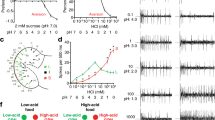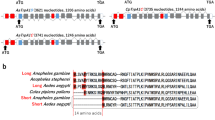Abstract
Chemical nociception, the detection of tissue-damaging chemicals, is important for animal survival and causes human pain and inflammation, but its evolutionary origins are largely unknown. Reactive electrophiles are a class of noxious compounds humans find pungent and irritating, such as allyl isothiocyanate (in wasabi) and acrolein (in cigarette smoke)1,2,3. Diverse animals, from insects to humans, find reactive electrophiles aversive1,2,3, but whether this reflects conservation of an ancient sensory modality has been unclear. Here we identify the molecular basis of reactive electrophile detection in flies. We demonstrate that Drosophila TRPA1 (Transient receptor potential A1), the Drosophila melanogaster orthologue of the human irritant sensor, acts in gustatory chemosensors to inhibit reactive electrophile ingestion. We show that fly and mosquito TRPA1 orthologues are molecular sensors of electrophiles, using a mechanism conserved with vertebrate TRPA1s. Phylogenetic analyses indicate that invertebrate and vertebrate TRPA1s share a common ancestor that possessed critical characteristics required for electrophile detection. These findings support emergence of TRPA1-based electrophile detection in a common bilaterian ancestor, with widespread conservation throughout vertebrate and invertebrate evolution. Such conservation contrasts with the evolutionary divergence of canonical olfactory and gustatory receptors and may relate to electrophile toxicity. We propose that human pain perception relies on an ancient chemical sensor conserved across ∼500 million years of animal evolution.
This is a preview of subscription content, access via your institution
Access options
Subscribe to this journal
Receive 51 print issues and online access
$199.00 per year
only $3.90 per issue
Buy this article
- Purchase on Springer Link
- Instant access to full article PDF
Prices may be subject to local taxes which are calculated during checkout




Similar content being viewed by others
References
Basbaum, A. I., Bautista, D. M., Scherrer, G. & Julius, D. Cellular and molecular mechanisms of pain. Cell 139, 267–284 (2009)
Bessac, B. F., Jordt, S. E. & Breathtaking, T. R. P. Channels: TRPA1 and TRPV1 in airway chemosensation and reflex control. Physiology 23, 360–370 (2008)
Eisner, T. in Chemical Ecology (eds Sondheimer, E. & Simeone, J. B.) 157–218 (Academic, 1970)
Thorne, N., Chromey, C., Bray, S. & Amrein, H. Taste perception and coding in Drosophila . Curr. Biol. 14, 1065–1079 (2004)
Wang, Z., Singhvi, A., Kong, P. & Scott, K. Taste representations in the Drosophila brain. Cell 117, 981–991 (2004)
Bandell, M. et al. Noxious cold ion channel TRPA1 is activated by pungent compounds and bradykinin. Neuron 41, 849–857 (2004)
Jordt, S. E. et al. Mustard oils and cannabinoids excite sensory nerve fibres through the TRP channel ANKTM1. Nature 427, 260–265 (2004)
Bautista, D. M. et al. TRPA1 mediates the inflammatory actions of environmental irritants and proalgesic agents. Cell 124, 1269–1282 (2006)
Kwan, K. Y. et al. TRPA1 contributes to cold, mechanical, and chemical nociception but is not essential for hair-cell transduction. Neuron 50, 277–289 (2006)
Hinman, A., Chuang, H. H., Bautista, D. M. & Julius, D. TRP channel activation by reversible covalent modification. Proc. Natl Acad. Sci. USA 103, 19564–19568 (2006)
Macpherson, L. J. et al. Noxious compounds activate TRPA1 ion channels through covalent modification of cysteines. Nature 445, 541–545 (2007)
Sokabe, T., Tsujiuchi, S., Kadowaki, T. & Tominaga, M. Drosophila painless is a Ca2+-requiring channel activated by noxious heat. J. Neurosci. 28, 9929–9938 (2008)
Rosenzweig, M., Kang, K. & Garrity, P. A. Distinct TRP channels are required for warm and cool avoidance in Drosophila melanogaster . Proc. Natl Acad. Sci. USA 105, 14668–14673 (2008)
Al-Anzi, B., Tracey, W. D. & Benzer, S. Response of Drosophila to wasabi is mediated by painless, the fly homolog of mammalian TRPA1/ANKTM1. Curr. Biol. 16, 1034–1040 (2006)
Gendre, N. et al. Integration of complex larval chemosensory organs into the adult nervous system of Drosophila . Development 131, 83–92 (2004)
Hamada, F. N. et al. An internal thermal sensor controlling temperature preference in Drosophila . Nature 454, 217–220 (2008)
Xiao, B. et al. Identification of transmembrane domain 5 as a critical molecular determinant of menthol sensitivity in mammalian TRPA1 channels. J. Neurosci. 28, 9640–9651 (2008)
Talavera, K. et al. Nicotine activates the chemosensory cation channel TRPA1. Nature Neurosci. 12, 1293–1299 (2009)
Kindt, K. S. et al. Caenorhabditis elegans TRPA-1 functions in mechanosensation. Nature Neurosci. 10, 568–577 (2007)
Ronquist, F. & Huelsenbeck, J. P. MrBayes 3: Bayesian phylogenetic inference under mixed models. Bioinformatics 19, 1572–1574 (2003)
Guindon, S., Delsuc, F., Dufayard, J. F. & Gascuel, O. Estimating maximum likelihood phylogenies with PhyML. Methods Mol. Biol. 537, 113–137 (2009)
Saitou, N. & Nei, M. The neighbor-joining method: a new method for reconstructing phylogenetic trees. Mol. Biol. Evol. 4, 406–425 (1987)
Yang, Z. PAML 4: phylogenetic analysis by maximum likelihood. Mol. Biol. Evol. 24, 1586–1591 (2007)
Bargmann, C. I. Comparative chemosensation from receptors to ecology. Nature 444, 295–301 (2006)
Nakagawa, T. & Vosshall, L. B. Controversy and consensus: noncanonical signaling mechanisms in the insect olfactory system. Curr. Opin. Neurobiol. 19, 284–292 (2009)
Gomes, R., Meek, M. E. & Eggleton, M. Concise International Chemical Assessment Document No 43 (World Health Organization, Geneva, 2002)
Viswanath, V. et al. Opposite thermosensor in fruitfly and mouse. Nature 423, 822–823 (2003)
Pulver, S. R., Pashkovski, S. L., Hornstein, N. J., Garrity, P. A. & Griffith, L. C. Temporal dynamics of neuronal activation by Channelrhodopsin-2 and TRPA1 determine behavioral output in Drosophila larvae. J. Neurophysiol. 101, 3075–3088 (2009)
Do, C. B., Mahabhashyam, M. S., Brudno, M. & Batzoglou, S. ProbCons: probabilistic consistency-based multiple sequence alignment. Genome Res. 15, 330–340 (2005)
Swofford, D. L. PAUP*. Phylogenetic Analysis Using Parsimony (*and Other Methods) version 4 (Sinauer Associates, Sunderland, MA, 2003)
Calleja, M., Moreno, E., Pelaz, S. & Morata, G. Visualization of gene expression in living adult Drosophila. Science 274, 252–255 (1996)
Joiner Ml, A. & Griffith, L. C. CaM kinase II and visual input modulate memory formation in the neuronal circuit controlling courtship conditioning. J. Neurosci. 17, 9384–9391 (1997)
Dunipace, L., Meister, S., McNealy, C. & Amrein, H. Spatially restricted expression of candidate taste receptors in the Drosophila gustatory system. Curr. Biol. 11, 822–835 (2001)
Tracey, W. D., Wilson, R. I., Laurent, G. & Benzer, S. painless, a Drosophila gene essential for nociception. Cell 113, 261–273 (2003)
Rosenzweig, M. et al. The Drosophila ortholog of vertebrate TRPA1 regulates thermotaxis. Genes Dev. 19, 419–424 (2005)
Waterhouse, A. M., Procter, J. B., Martin, D. M. A., Clamp, M. & Barton, G. J. Jalview version 2: a multiple sequence alignment and analysis workbench. Bioinformatics 25, 1189–1191 (2009)
Livingstone, C. D. & Barton, G. J. Protein sequence alignments: a strategy for the hierarchical analysis of residue conservation. Comput. Applic. Biosci. 9, 745–756 (1993)
Le, S. Q. & Gascuel, O. An improved general amino acid replacement matrix. Mol. Biol. Evol. 25, 1307–1320 (2008)
Acknowledgements
We thank H. Amrein, G. Boekh, K. Scott, D. Tracey and Bloomington Stock center for flies, C. Miller-Patterson and D. Zeiger for assistance, and members of the Garrity laboratory, J. P. Garrity, L. Huang, E. Marder, S. Nelson, G. Turrigiano and M. Rosbash for comments. This work was supported by grants from the NIMH (R21 MH080206, P.A.G.; RO1 MH067284, L.C.G.), NINDS (PO1 NS044232), and the Royal Society (Newton International Fellowship, S.R.P.).
Author Contributions K.K., S.R.P., V.C.P., D.L.T. and P.A.G. designed experiments. K.K. performed molecular genetics, behaviour and oocyte physiology, S.R.P. performed neuromuscular junction electrophysiology. E.C.C. assisted with behaviour, D.L.T., V.C.P. and P.A.G. performed bioinformatics, and K.K. and P.A.G. wrote the paper with assistance from S.R.P., V.C.P., L.C.G. and D.L.T.
Author information
Authors and Affiliations
Corresponding author
Ethics declarations
Competing interests
The authors declare no competing financial interests.
Supplementary information
Supplementary Figures
This file contains Supplementary Figures 1-9 with Legends. (PDF 2749 kb)
Rights and permissions
About this article
Cite this article
Kang, K., Pulver, S., Panzano, V. et al. Analysis of Drosophila TRPA1 reveals an ancient origin for human chemical nociception. Nature 464, 597–600 (2010). https://doi.org/10.1038/nature08848
Received:
Accepted:
Published:
Issue Date:
DOI: https://doi.org/10.1038/nature08848
This article is cited by
-
The pharyngeal taste organ of a blood-feeding insect functions in food recognition
BMC Biology (2024)
-
Post-injury pain and behaviour: a control theory perspective
Nature Reviews Neuroscience (2023)
-
Alkaline taste sensation through the alkaliphile chloride channel in Drosophila
Nature Metabolism (2023)
-
Research Progress on TRPA1 in Diseases
The Journal of Membrane Biology (2023)
-
Molecular sensors in the taste system of Drosophila
Genes & Genomics (2023)
Comments
By submitting a comment you agree to abide by our Terms and Community Guidelines. If you find something abusive or that does not comply with our terms or guidelines please flag it as inappropriate.



